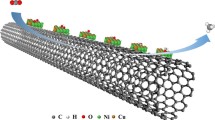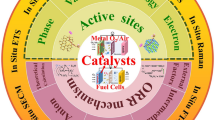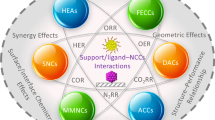Abstract
Electro-oxidation of Ni(poly) in 0.5 M aqueous KOH solution at various polarization potentials (E p) up to 0.5 V vs. reversible hydrogen electrode, for polarization times (t p) up to 2 h, and at 285 ≤ T ≤ 318 K leads to the formation of a thin layer of α-Ni(OH)2. Interfacial capacitance measurements show that the Ni(poly) electrode covered with a layer of α-Ni(OH)2 can be completely reduced back to its metallic state by applying a negative-going potential scan with a lower potential limit of −0.2 V. An increase of E p, t p, and/or T results in an increase of the thickness of the α-Ni(OH)2 layer, which, however, never exceeds two monolayers. The electrochemical formation of α-Ni(OH)2 follows a direct logarithmic growth kinetic law. The results reported in this contribution and their interpretation imply that other oxide growth theories, such as the Langmuir-type adsorption, the point defect model, the electron tunneling, or the nucleation-and-growth model, are not applicable to the growth of α-Ni(OH)2. The potentiostatic growth of α-Ni(OH)2 on Ni(poly) is successfully treated by applying the interfacial place-exchange mechanism and the associated kinetic law.










Similar content being viewed by others
References
S. Trasatti (ed.), Electrodes of Conductive Metallic Oxides. Part A. Studies in Physical and Theoretical Chemistry (Elsevier, Amsterdam, 1980)
M. Fleischmann, K. Korinek, D. Pletcher, J. Chem. Soc. Perkin Trans. II 10, 1396 (1972)
J. Kleperis, G. Wójcik, A. Czerwiński, J. Skowroński, M. Kopczyk, M. Bełtowska-Brzezińska, J. Solid State Electrochem. 5, 229 (2001)
J. Desilvestro, O. Haas, J. Electrochem. Soc. 137, 5C (1990)
H. Wendt, G. Imarisio, J. Appl. Electrochem. 18, 1 (1988)
J.M. Skowroński, A. Ważny, J. Solid State Electrochem. 9, 890 (2005)
S.P. Jiamg, S.H. Chan, J. Mat. Sci. 39, 4405 (2004)
W.C. Dautremont-Smith, Displays 3, 67 (1982)
S.H. Lee, C.E. Tracy, J.R. Pitts, Electrochem. Solid State Letters 7, A299 (2004)
A. Lasia, A. Rami, J. Electroanal. Chem. 294, 123 (1990)
B.E. Conway, T. Liu, J. Chem. Soc., Faraday Trans. I 83, 1063 (1987)
S. Maximovitch, R. Durand, J. Electroanal. Chem. 149, 273 (1983)
R. Sandoval, R. Schrebler, H. Gómez, J. Electroanal. Chem. 210, 287 (1986)
C.A. Melendres, M. Pankuch, J. Electroanal. Chem. 333, 103 (1992)
A. Seghiouer, J. Chevalet, A. Barhoun, F. Lantelme, J. Electroanal. Chem. 442, 113 (1998)
F. Hahn, D. Floner, B. Beden, C. Lamy, Electrochim. Acta 32, 1631 (1987)
R.J. Smith, R.E. Hummel, J.R. Ambrose, Corros. Sci. 27, 815 (1987)
L.M.M. de Souza, F.P. Kong, F.R. McLarmont, R.H. Muller, Electrochim. Acta 42, 1253 (1997)
Z.I. Kudriavceva, V.A. Openkin, N.A. Zhuchkova, E.I. Khrushcheva, N.A. Shutilova, Elektrokhimiya 11, 1392 (1975)
H.W. Hoppe, H.H. Strehblow, Surf. Interf. Anal. 14, 121 (1989)
S.L. Yau, F.R.F. Fan, T.P. Moffat, A.J. Bard, J. Phys. Chem. 98, 5493 (1994)
A. Seyeux, V. Maurice, L.H. Klein, P. Marcus, J. Solid State Electrochem. 9, 337 (2005)
A.G. Pshenichnikov, L.A. Burkal'tseva, Z.I. Kudryavtseva, Electrochim. Acta 45, 4143 (2000)
J. Nan, Y. Yang, Z. Lin, Electrochim. Acta 51, 4873 (2006)
M. Grdeń, K. Klimek, J. Electroanal. Chem. 581, 122 (2005)
W. Paik, Z. Szklarska-Smialowska, Surf. Sci. 96, 401 (1980)
A.A. Wronkowska, Surf. Sci. 214, 507 (1989)
G. Larramona, C. Gutiérrez, J. Electrochem. Soc. 137, 428 (1990)
M.J. Madou, M.C.H. McKubre, J. Electrochem. Soc. 130, 1056 (1983)
A. Seyeux, V. Maurice, L.H. Klein, P. Marcus, J. Electrochem. Soc. 153, B453 (2006)
A. Seyeux, V. Maurice, L.H. Klein, P. Marcus, Electrochim. Acta 54, 540 (2008)
R. Simpraga, B.E. Conway, J. Electroanal. Chem. 280, 341 (1990)
M. Grdeń, K. Klimek, A. Czerwiński, J. Solid State Electrochem. 8, 390 (2004)
D.V. Sokolskii, B.Y. Nogerbekov, N.N. Gudeleva, R.G. Mustafina, Elektrokhimiya 22, 1114 (1986)
H.W. Hoppe, H.H. Strehblow, Corr. Sci. 31, 167 (1990)
P. Oliva, J. Leonardi, J.F. Laurent, C. Delmas, J.J. Braconnier, M. Figlarz, F. Fievet, A. de Guibert, J. Power Sources 8, 229 (1982)
C.V. D’Alkaine, M.A. Santanna, J. Electroanal. Chem. 457, 5 (1998)
W. Visscher, E. Barendrecht, Electrochim. Acta 25, 651 (1980)
H. Bode, K. Dehmelt, J. Witte, Electrochim. Acta 11, 1079 (1966)
R.S. McEwen, J. Phys. Chem. 76, 1782 (1971)
G. Barral, F. Njanjo-Eyoke, S. Maximovitch, Electrochim. Acta 40, 2815 (1995)
H.J. Jang, C.J. Park, H.S. Kwon, Electrochim. Acta 50, 3503 (2005)
D.A. Bonnell, Prog. Surf. Sci. 57, 187 (1998)
C. Zhang, S.M. Park, J. Electrochem. Soc. 136, 3333 (1989)
J.F. Wolf, L.S.R. Yeh, A. Damjanovic, Electrochim. Acta 26, 811 (1981)
H. Angerstein-Kozlowska, B.E. Conway, W.B.A. Sharp, J. Electroanal. Chem. 43, 9 (1973)
B.E. Conway, W.B.A. Sharp, H. Angerstein-Kozlowska, E.E. Criddle, Anal. Chem. 45, 1331 (1973)
S.A.S. Machado, L.A. Avaca, Electrochim. Acta 39, 1385 (1994)
B.A. Boukamp, Solid State Ionics 20, 31 (1986)
R.D. Armstrong, M. Henderson, J. Electroanal. Chem. 39, 81 (1972)
D.A. Harrington, B.E. Conway, Electrochim. Acta 32, 1703 (1987)
G.J. Brug, A.L.G. Van Den Eeden, M. Sluyters-Rehbach, J.H. Sluyters, J. Electroanal. Chem. 176, 275 (1984)
E. Navarro-Flores, S. Omanovic, J. Mol. Catal. A: Chemical 242, 182 (2005)
P. Zoltowski, Electrochim. Acta 38, 2129 (1993)
S. Trasatti, O.A. Petrii, Pure Appl. Chem. 63, 711 (1991)
M. Dmochowska, A. Czerwiński, J. Solid State Electrochem. 2, 16 (1998)
D. Floner, C. Lamy, J.M. Leger, Surf. Sci. 234, 87 (1990)
S. Srinivasan, E. Gileadi, Electrochim. Acta 11, 321 (1966)
B. Scharifker, G. Hills, Electrochim. Acta 28, 879 (1983)
R. Philipp, U. Retter, Electrochim. Acta 40, 1581–1585 (1995)
D.D. MacDonald, Transient Techniques in Electrochemistry (Plenum, New York, 1977)
S. Maximovitch, Electrochim. Acta 41, 2761 (1996)
W.P. Gomes, D. Vanmaekelbergh, Electrochim. Acta 41, 967 (1996)
V.A. Myamlin, Yu.V. Pleskov, Electrochemistry of Semiconductors (Plenum, New York, 1967)
K. Darowicki, S. Krakowiak, P. Ślepski, Electrochim. Acta 51, 2204 (2006)
G. Barral, S. Maximovitch, F. Njanjo-Eyoke, Electrochim. Acta 41, 1305 (1996)
W.P. Gomes, F. Cardon, Prog. Surf. Sci. 12, 155 (1982)
A. di Paola, Electrochim. Acta 34, 203 (1989)
M.J. Madou, F. Cardon, W.P. Gomes, J. Electrochem. Soc. 124, 1623 (1977)
H.S. Jarret, J. Electroanal. Chem. 150, 629 (1983)
M. Boinet, S. Maximovitch, F. Dalard, O. de Bouvier, J. Mat. Sci. 38, 4041 (2003)
M.H. Dean, U. Stimming, Corr. Sci. 29, 199 (1989)
H. Uhlig, J. Pickett, J. MacNairn, Acta Met. 7, 111 (1959)
H.H. Uhlig, Acta Met. 4, 541 (1956)
H.P. Rooksby, Acta Cryst. 1, 226 (1948)
T. Eto, S. Endo, M. Imai, Y. Katayama, T. Kikegawa, Phys. Rev. B 61, 14984 (2000)
A. Delahaye-Vidal, B. Beaudoin, N. Sac-Epée, K. Tekaia-Elhsissen, A. Audemer, M. Figlarz, Solid State Ionics 84, 239 (1996)
S.I. Pyun, M.H. Hong, Electrochim. Acta 37, 327 (1992)
C.Y. Chao, L.F. Lin, D.D. Macdonald, J. Electrochem. Soc. 128, 1187 (1981)
A.T. Fromhold Jr., J. Phys. Chem. Solids 24, 1309 (1963)
D. Gilroy, J. Electroanal. Chem. 71, 257 (1976)
B.E. Conway, B. Barnett, H. Angerstein-Kozlowska, B.V. Tilak, J. Chem. Phys. 93, 8361 (1990)
A.T. Fromhold Jr., J. Electrochem. Soc. 153, B97 (2006)
A.T. Fromhold Jr., E.J. Cook, Phys. Rev. 158, 600 (1967)
W. Schmickler, J. Electroanal. Chem. 84, 203 (1977)
R. Philipp, J. Dittrich, U. Retter, E. Müller, J. Electroanal. Chem. 250, 159 (1988)
B.E. Conway, G. Jerkiewicz, J. Electroanal. Chem. 339, 123 (1992)
G. Tremiliosi-Filho, L.H. Dall'Antonia, G. Jerkiewicz, J. Electroanal. Chem. 578, 1 (2005)
L.H. Dall'Antonia, G. Tremiliosi-Filho, G. Jerkiewicz, J. Electroanal. Chem. 502, 72 (2001)
M. Alsabet, M. Grdeń, G. Jerkiewicz, J. Electroanal. Chem. 589, 120 (2006)
T.V. Blank, Y.A. Goldberg, Semiconductors 41, 1263 (2007)
N.W. Grimes, R.W. Grimes, J. Phys.: Condens. Matter 9, 6737 (1997)
D. R. Lide (ed.) CRC Handbook of Chemistry and Physics (CRC, Boca Raton, 1995)
Acknowledgments
We acknowledge financial support from the NSERC of Canada and Queen’s University, and on-going collaboration with VALE (formerly Vale-Inco). M. Alsabet thanks Kuwait University for a graduate fellowship. M. Grden acknowledges a leave of absence from Warsaw University.
Author information
Authors and Affiliations
Corresponding author
Appendix
Appendix
In the manuscript, we discuss the dependence of the slope of q ox vs. log t p plots on E p and assign it to the change in the structure of the Ni(OH)2 oxide layer. Here, we justify why this dependence cannot be the result of (a) a variation in the μ value as the electric field changes or (b) a change in the structure of the electrode–electrolyte interface.
With regards to (a), at a first glance, the dependency of the slope of q ox vs. log t p relationships on E p could be the result of a variation in the dipole moment induced by varying the value of E el, which is related to E p. This proposal is examined by the following simple calculations. We assume that the strength of the electric field within the oxide/hydroxide film is of the order of 108 V m–1 for a potential drop of 0.1 V [88, 90] and that the value of NiO polarizability volume (α′) is ca. 4 Å3 [92]. Although we did not found any polarizability data for NiOH, we can assume that its value is similar to that of NiO. Thus, we can apply a simplified formula to estimate the influence of changes in the electric field on the induced dipole moment (μ ind) using Eq. 9
where ΔE el is the change in electric field, related to the change in the electrode potential. The factor 1.1126 × 10–16 contains the vacuum dielectric permittivity and π [93]. Thus, for a potential difference of 0.1 V, we expect ΔE el to be of the order of 108 V m–1 [88, 90]. After introducing this value into Eq. 9, we obtain a change of the dipole moment of the order of 10–3 D. Assuming that in the case of Ni electro-oxidation the dipole moment calculated using Eq. 3 is of the order of μ = 1.17–1.56 D (see the main body of the manuscript), the value of μ ind is insignificant and cannot explain 6–48% changes in the slope of the q ox vs. log t p relationships.
With regards to (b), in the case of formation of oxide layers on Au and Pt electrodes, Conway et al. [82] suggested, but never proved, that the slope of the q ox vs. log t p relationships could depend on E p in the very initial stages of electro-oxidation. They attributed this effect to simultaneously occurring surface processes, such as anion adsorption. The surface coverage of the electrode with various adsorbed species such as water and/or hydroxyl anions is expected to be potential dependent. Thus, various arrangements of adsorbed species at different potential values could influence the structure of surface oxide/hydroxide layer and result in the potential dependence of the q ox vs. log t p relationships. However, the potential dependent H2O/OH− surface coverage could affect the slope of the q ox vs. log t p plots, thus changing the surface area (A in Eq. 3) available for the formation of Ni(OH)2. On the remaining, uncovered surface, the oxidation would have to follow H2O/OH− adsorption, therefore resulting only in a slightly different slope of the q ox vs. log t p relationships on E p, which is not the case. It is worthwhile adding that the adsorption of K+ cations originating from the electrolyte was considered not to have any significant influence on the Ni electro-oxidation [25].
Rights and permissions
About this article
Cite this article
Alsabet, M., Grden, M. & Jerkiewicz, G. Electrochemical Growth of Surface Oxides on Nickel. Part 1: Formation of α-Ni(OH)2 in Relation to the Polarization Potential, Polarization Time, and Temperature. Electrocatal 2, 317–330 (2011). https://doi.org/10.1007/s12678-011-0067-9
Published:
Issue Date:
DOI: https://doi.org/10.1007/s12678-011-0067-9




